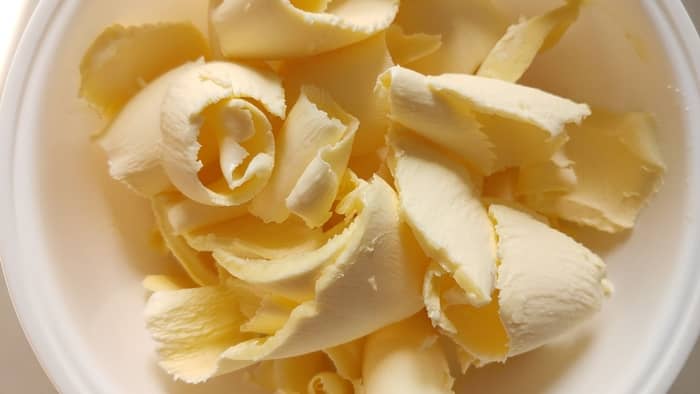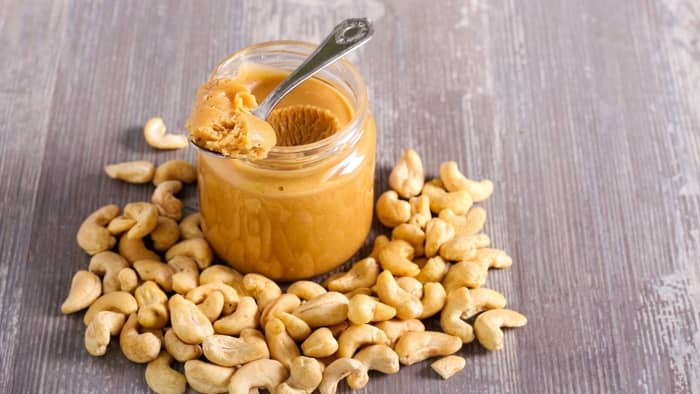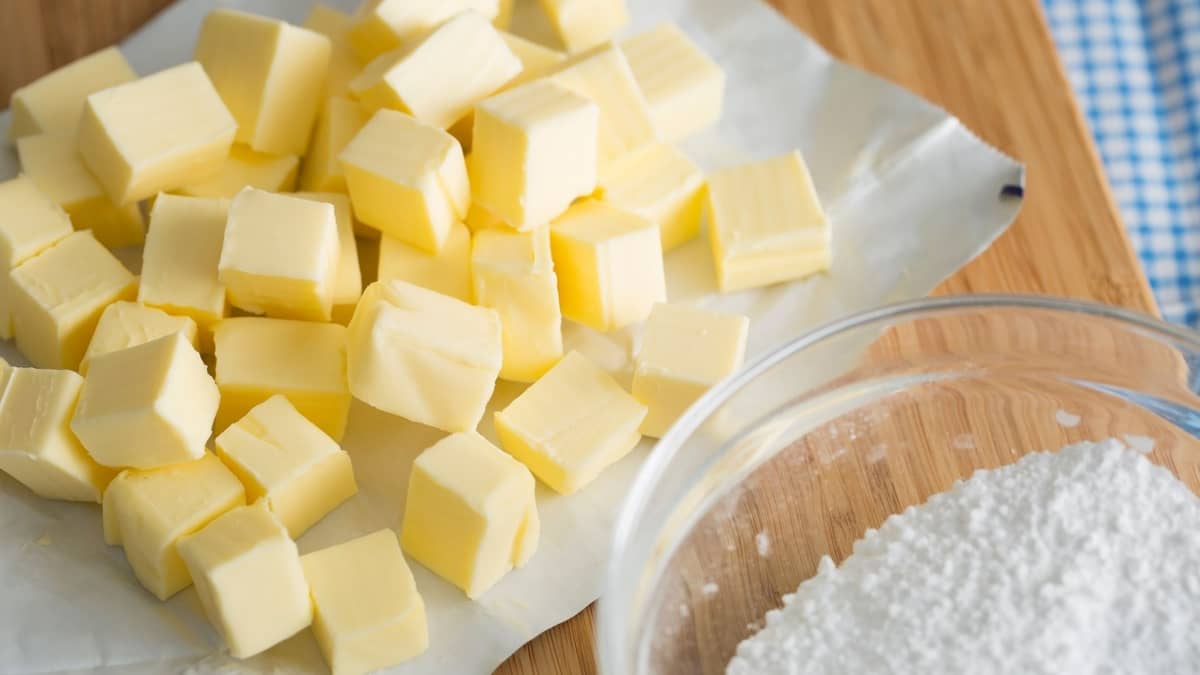Last Updated on January 27, 2023
Are you wondering about the functions of butter in baking? In this article, we will discuss what it is, how it works, and the functions it can perform.
Butter is a surprisingly useful ingredient and you’ll be surprised to learn how crucial it is to many baked items. To name a few, it promotes flavor, creates a tender crumb, and helps enrich products. To learn more about the functions and how you can even substitute butter, read on.
What is Butter?
This may seem like a very silly question to ask, but you would be surprised how many fake butters there are! Or, how many people think margarine is the same thing as butter?!
Butter is a type of dairy product made from an emulsion of the fat and proteins of churned cream. This product contains about 80% milkfat (aka. butterfat), 10-15% water, and 5% milk solids. Butterfat is the fat that is present in milk and cream. Butter is a semi-solid product at room temperature and melts into a liquid when it is heated.
This handy ingredient has many uses. It is mainly used as a flavoring ingredient, to enrich products, and to help add structure to baked goods. It can also be used to adjust the consistency of many recipes, like batters and sauces.
Salted vs unsalted – what’s the difference? Salted butter contains salt. Regular butter doesn’t contain any salt and is labeled as “unsalted butter”. These two kinds of butter can be used interchangeably, but they will affect the flavor of your final product.
For example, when using salted butter, will add some saltiness to your recipe. So, if you are substituting regular (unsalted) butter with salted butter, remove half of the fine salt called for in the recipe. This will help you prevent over-salting the dish or baked goods.
When substituting salted butter with regular butter, then you may want to add a pinch of fine salt to the recipe as well.

Butter vs margarine
Butter is made from dairy (an animal-based ingredient) and is very high in saturated fats. Margarine, on the other hand, is made from plant oils, meaning it is often completely vegan.
Margarine is commonly referred to as the original vegan butter. People just never realized that’s what it is.
Now, both these ingredients can be used interchangeably, however, each has its benefits and downsides. For example, margarine won’t add a rich and complex flavor, but it generally does add a better texture to products like cookies.
What Butter is Used For Baking? Unlocking its Delicious Potential
As you probably already know, butter is a common ingredient in baking recipes known for its ability to improve taste and texture and add richness to all kinds of baked products. In addition, it is frequently used in place of other popular fats such as vegetable oil or shortening, because some simply like to elevate their dishes in this way.
Due to the amount of salt in salted butter fluctuating between brands and even batches, it is critical to use the unsalted one in baking. Although many people believe that there isn’t much of a difference between unsalted and salted ones, the reality is very different. It’s not just about the pinch of salt here, it’s about the whole experience.
This, at first glance, perhaps not so important difference has its purpose and what is most important of all, can affect the overall flavor of the baked goods, making them overly salty or unevenly seasoned. Accordingly, using unsalted butter allows the baker to have more control over the amount of salt in the recipe and to season the baked goods to taste.
Furthermore, unsalted butter allows the baker to add their preferred ratio of salt and other flavors to the recipe, whereas the salted one has a unique flavor that may dominate other components in the recipe. Don’t forget that it is simply favored in some particular recipes, such as pastry since it contains a larger percentage of fat, which is required for pastry creation. It also includes less water, which helps the pastry stay flaky and delicate.
Another thing to pay attention to is the temperature itself. It is preferable to keep the butter as close to room temperature as possible for two simple reasons. Namely, cold butter will not cream well, while melted butter can cause the dough to be too wet, which every baker wants to avoid, right?
This versatile ingredient can be used in various ways such as creaming, melting, cutting, or spreading on top of the dough before baking, and the most important thing is to use unsalted butter while making sure it is at the right temperature.
Functions Of Butter: What Does Butter Do in Baking?
Using butter in baking has a ton of benefits. And, for many dishes, it is a must-add! Butter has a ton of different functions from adding flavor to improving the structure. We will be discussing each in-depth below.
Adds flavor
This is always the first function you will hear people talk about. Butter adds a very rich and semi-sweet flavor. If you are using salted butter, naturally it will also add some saltiness to your recipe.
While it adds flavor, it also adds a creaminess that helps carry the other flavors better. It is definitely an enriching ingredient, which is why you will often find enriched bread containing this ingredient specifically.
Improves texture
Butter, but really any type of fat, helps improve the texture of baked goods by making them more tender. This happens because fat helps inhibit the development of gluten (it shortens gluten strands).
How this takes place is as follows; the fat coats the protein found in the flour. When the proteins are coated, they cannot be worked to develop stretchy gluten strands. And, if the gluten strands remain “short”, it creates a more tender crumb.
This is key for baked goods like cookies, cakes, muffins, and even some pastries.
Helps the leavening process
Now, using butter as a leavening agent isn’t commonly heard of. But, butter is actually a fantastic way to leaven your products and give them a specific amount of lift.
Using butter in baking is always incorporated in a few specific ways. If you want to use it for leavening purposes, you have to cream (or whip) the butter first. By doing this, you are introducing air into the butter. When a batter is made and baked, the air molecules expand and give the mixture lift.
Another way this works is with the moisture (water molecules) in the butter itself. Remember, butter contains about 10-15% water. So, when the batter is baked, the water evaporates, creates steam, and gives the product its lift.
Bruntmor Elegant Ceramic Butter Dish with Lid, Covered Butter Keeper
Does butter make a difference in baking?
By using butter in baking, you are adding more flavor, enriching the product, and making it more tender. And, depending on how you incorporate it, you can also give extra rise to your products. So yes, using butter in baking makes a massive difference.
And, even though other types of fat also functionsimilarlyy, they don’t have the delicious and enriching flavor that butter has.
Is it better to melt butter for cakes?
Melting butter is a technique developed to incorporate butter into recipes where it is not used in its solid form as it provides several benefits for baking. The thing is that when melted, butter becomes a liquid, which can be easily incorporated into other ingredients, such as flour, sugar, and eggs. This helps to create a more homogeneous batter, which leads to a more consistent texture in the final baked goods.
Furthermore, melting the butter allows it to be spread more evenly throughout the cake batter. This might result in a more evenly cooked and flavorful finished product.
Using melted butter generally creates denser cakes and products in general. So, when it comes to which form of butter is better to use, it depends entirely on what you want the texture (or structure) of your item to be.
Melted butter thins a cake batter and will not give it much airiness. So, as we said, it will make the structure of the cake denser. If you want a light and airy cake, you may want to use creamed butter.
The Perfect Melt: Best Way to Melt Butter for Baking
This common technique is used in baking recipes such as brownies, quickbreads, and some cakes, but it is also used as a finishing touch for some dishes like vegetables or pasta. There are various methods for melting butter, however, the following one is regarded as the best:
- Make tiny chunks of butter. This will help in the even and quick melting of the butter.
- Place the butter in a heatproof bowl, such as a glass or stainless steel bowl.
- Place the bowl on top of a saucepan of heating water. This method is referred to as a double boiler because it offers mild heat while preventing the butter from burning.
- Lightly and occasionally stir the butter with a heatproof spatula until it is completely melted. Keep an eye on the butter as it melts; if left unattended, it can burn much faster than you can imagine.
- Remove the bowl from the heat once the butter has completely melted and allow it to cool slightly before using it in the recipe.
In addition to the double boiler method, there are a few other ways to melt butter:
Using a food processor:
Pulse the butter in a food processor until it is completely melted. This approach is quick and simple, but it can be messy, so we recommend that you use a food processor with a low-profile bowl.
Using a microwave:
Heat the butter in a microwave-safe bowl in 30-second increments on low power, stirring after each interval. Take care not to overheat the butter, since as we already mentioned, it can easily burn.
Using a mixer (hand or standing):
This method is great, the only difference being that the hand mixer method is more suitable for small-batch recipes, while the standing mixer method, on the other hand, is more appropriate for recipes that require larger amounts of butter.
Using a sous-vide:
Although you might not think of it at first, you can definitely melt butter in a vacuum-sealed bag using a sous-vide immersion circulator. This technique is accurate and consistent, and it works well with large amounts of butter.
What Are Some Vegan Butter Substitutes?
There are many vegan substitutes for butter that will function in a very similar way. The biggest difference they will make is the flavor they add. For example, almond butter will add an almond flavor to your recipe.
Margarine is the most common vegan butter. However, always check the ingredients list to make sure it is completely vegan. Some companies add animal-based products to add more flavor, color, or preserving agents.
Other vegan butter in baking substitutes include cashew butter, silken tofu, applesauce, coconut butter, and mashed banana.

Butter Bakers Paradise: Baking Recipes That Use a Lot of Butter
Many baking recipes call for a lot of butter because it adds taste, texture, and richness to the final, baked result. Cakes, cookies, pastries, and bread are just some of the biggest fans of butter.
As we have already stated, butter is a natural emulsifier that aids in the combining of components to create a smooth and homogeneous batter or dough. It also contributes to keeping baked goods moist and soft by coating the flour proteins, making them less prone to gluten formation.
Popular baking recipes that use a lot of butter include:
Croissants: These popular French pastries are made with huge amounts of butter, which is layered into the dough to make it flaky and buttery.
Pound Cake: This timeless classic is made with equal parts butter, sugar, eggs, and flour, and therefore has a rich, buttery taste and a dense, moist texture.
Chocolate Chip Cookies: Anyone who has made them at least once knows what we are talking about. Butter is used to provide a rich and buttery flavor and to keep them soft and chewy, just the way they should be.
Brioche: Made with a large amount of butter, this fantastic bread has a rich, buttery flavor and a light, fluffy texture.
Butter In Baking – Final Words
As you can see, using butter in baking is crucial for some baked goods to help promote good texture and a rich flavor. Feel free to share this article with your fellow bakers to help inform them of the many functions of butter and how it works.
What does butter do in baking?
Butter helps give baked goods a very tender crumb, good creamy flavor, and an enriched texture. It can also promote excellent rise in products by being creamed (aerated).
Does butter make a difference in baking?
Butter makes a massive difference in baked products. It can help shorten the gluten strands in your dough or batter, which will create a more tender crumb. It also helps add flavor,. helps leaven products, and create a creamy enriched texture.
Is it better to melt butter for cakes?
When deciding to use melted butter in a cake, it depends on what texture you want. Melted butter will cerate a denser texture in cakes as it thins the batter. So, if you want an air cake, rather use creamed butter instead.

Lindy Van Schalkwyk is a culinary specialist with a background in Advanced Cooking, Advanced Pâtisserie, Media Communications and Nutrition. She has gained invaluable experience in the culinary industry having worked in some of the top restaurants in Africa in 2016 and 2017. Her expertise in nutrition has enabled her to develop recipes for special dietary needs. In 2018, Lindy began working in the Food Media industry, focusing on recipe development, recipe writing, food writing and food styling.


